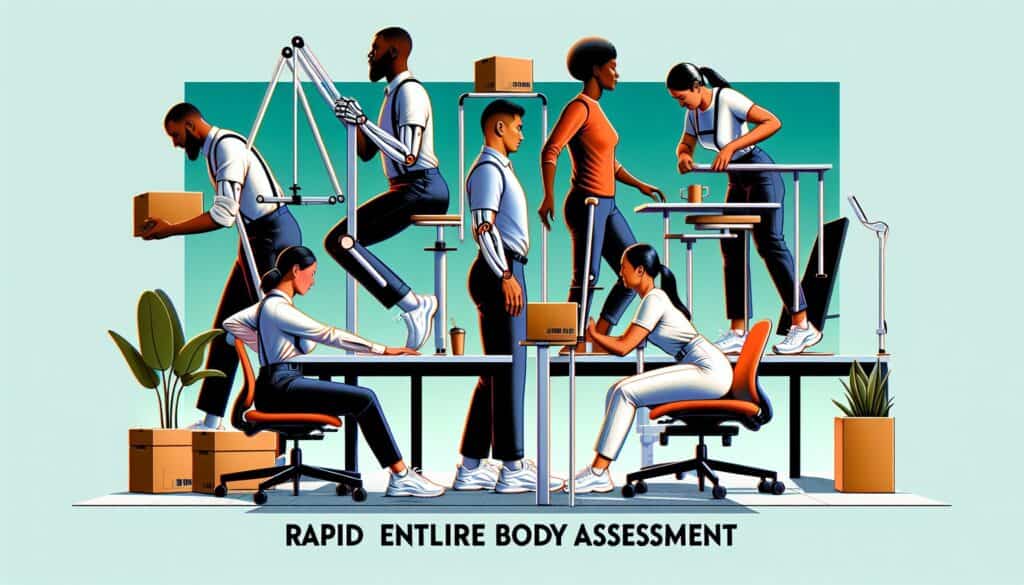Ein Beobachtungsinstrument zur Bewertung des Haltungsrisikos für arbeitsbedingte Muskel-Skelett-Erkrankungen am ganzen Körper.
- Methodologien: Maschinenbau, Ergonomie
REBA (Rapid Entire Body Assessment)

REBA (Rapid Entire Body Assessment)
- Kontinuierliche Verbesserung, Ergonomie, Menschliche Faktoren, Human-Centered Design, Schlanke Fertigung, Prozessverbesserung, Qualitätsmanagement, Risikomanagement, Sicherheit
Zielsetzung:
Wie es verwendet wird:
- Bewertet die Haltung von Nacken, Rumpf, Beinen und Armen sowie die Kopplung, Belastung/Kraft und Aktivität. Es werden Punktzahlen erstellt, die den Grad des EBA-Risikos und die Dringlichkeit von Maßnahmen anzeigen.
Vorteile
- Bietet eine ganzheitliche Bewertung der Haltungsrisiken für den gesamten Körper; ist relativ schnell einsetzbar; hilft bei der Priorisierung von Arbeitsplätzen für ergonomische Verbesserungen.
Nachteile
- Kann subjektiv sein; erfordert Schulung für eine konsistente Bewertung; ist in erster Linie ein Screening-Instrument, das für eine detaillierte Interventionsplanung möglicherweise weitere Analysen erfordert.
Kategorien:
- Ergonomie
Am besten geeignet für:
- Bewertung des Haltungsrisikos für Muskel-Skelett-Erkrankungen, die den ganzen Körper betreffen.
Die REBA-Methode (Rapid Entire Body Assessment) findet in verschiedenen Branchen Anwendung, z. B. in der Fertigung, im Baugewerbe, im Gesundheitswesen und in der Logistik, wo die Mitarbeiter häufig mit Aufgaben beschäftigt sind, die repetitive Bewegungen oder anhaltende ungünstige Körperhaltungen erfordern. Diese Bewertung ist besonders in der Entwurfsphase von Arbeitsplätzen oder Arbeitsabläufen wertvoll, vor allem wenn es darum geht, die körperlichen Anforderungen an die Mitarbeiter zu berücksichtigen, und ermöglicht es den Teams, bestimmte Aufgaben, die zu Verletzungen führen könnten, zu bewerten und neu zu gestalten. In den Bereichen Technik und Produktdesign sind häufig Ergonomen, Gesundheits- und Sicherheitsexperten sowie Teamleiter beteiligt, die für die Optimierung der Arbeitsabläufe verantwortlich sind. Die Methodik erleichtert eine objektive Bewertung, indem sie numerische Punktzahlen generiert, die den Grad des Risikos von Muskel-Skelett-Erkrankungen (MSD) in Verbindung mit bestimmten Körperhaltungen und Aufgaben kategorisieren und so Arbeitsplätze für ergonomische Interventionen priorisieren. Die schnelle Anwendung von REBA ermutigt zum Einsatz in Routinebeurteilungen, die es Unternehmen ermöglichen, Veränderungen in der Körperhaltung und den Arbeitsbedingungen regelmäßig zu überwachen, um letztlich die Verletzungsrate zu senken und das Wohlbefinden der Arbeitnehmer zu verbessern. Es könnten Schulungen organisiert werden, um die Mitarbeiter auf allen Ebenen über REBA zu informieren und ein Bewusstsein für ergonomische Prinzipien zu schaffen, die eine sicherere Arbeitsumgebung fördern. Die regelmäßige Anwendung dieser Beurteilungen trägt nicht nur zur Einhaltung der arbeitsmedizinischen Richtlinien bei, sondern steigert auch die Produktivität, indem sie Ermüdung und Fehlzeiten im Zusammenhang mit Muskel- und Skeletterkrankungen verringert.
Die wichtigsten Schritte dieser Methodik
- Beobachten Sie die Körperhaltung des Arbeitnehmers während der Arbeit.
- Bewerten Sie die Haltung von Nacken, Rumpf, Beinen und Armen anhand vordefinierter Bewertungskriterien.
- Bewerten Sie den Grad der Kopplung zwischen den Körperteilen während der Aufgabe.
- Bewerten Sie jede auf den Körper ausgeübte Last oder Kraft.
- Berücksichtigen Sie die ausgeübte Tätigkeit und deren Anforderungen.
- Berechnen Sie die Gesamtpunktzahl auf der Grundlage der einzelnen Bewertungen.
- Bestimmen Sie anhand des Scores das Risiko für Muskel-Skelett-Erkrankungen.
- Setzen Sie auf der Grundlage der Beurteilungsergebnisse Prioritäten für die Notwendigkeit von Maßnahmen.
Profi-Tipps
- Einbeziehung eines dynamischen Bewertungsansatzes durch Kombination von REBA-Ergebnissen mit einer Zeit-Bewegungs-Studie, um das Verständnis für sich wiederholende Aufgaben und deren Auswirkungen auf die Körperhaltung der Arbeitnehmer zu verbessern.
- Nutzung digitaler Hilfsmittel, wie z. B. Software zur Bewegungserfassung, zur Ergänzung der REBA-Analyse, um Haltungsrisiken und Kraftanwendungen genauer zu ermitteln.
- Regelmäßige Aktualisierung der REBA-Bewertungskriterien auf der Grundlage neuer Forschungsergebnisse und bewährter Verfahren, um Relevanz und Genauigkeit bei der Bewertung moderner Arbeitsumgebungen zu gewährleisten.
Verschiedene Methoden lesen und vergleichen, Wir empfehlen die
> Umfassendes Methoden-Repository <
zusammen mit den über 400 anderen Methoden.
Ihre Kommentare zu dieser Methodik oder zusätzliche Informationen sind willkommen auf der Kommentarbereich unten ↓ , sowie alle ingenieursbezogenen Ideen oder Links.
Historischer Kontext
1986
(wenn das Datum nicht bekannt oder nicht relevant ist, z. B. "Strömungsmechanik", wird eine gerundete Schätzung des bemerkenswerten Erscheinens angegeben)

Verwandte Artikel
Fragebögen zu muskuloskelettalen Beschwerden
Multivariate Tests (MVT)
Mehrfache Regressionsanalyse
Motion-Capture-Systeme
MoSCoW-Methode
Moods Median-Test